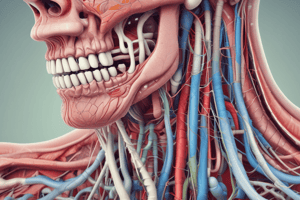Podcast
Questions and Answers
Which one of the following is NOT a major salivary gland?
Which one of the following is NOT a major salivary gland?
- Minor salivary gland (correct)
- Submandibular gland
- Parotid gland
- Sublingual gland
Which type of cells help with the expulsion of saliva along the course of the duct?
Which type of cells help with the expulsion of saliva along the course of the duct?
- Myoepithelial cells (correct)
- Intercalated duct cells
- Striated duct cells
- Acinar cells
What is the function of saliva?
What is the function of saliva?
- Lubricates and protects oral tissues
- Aids in control of microbial flora in the oral cavity
- Starts digestion of complex carbohydrates
- All of the above (correct)
Which organ develops from the gut tube and maintains contact with other digestive organs via ducts?
Which organ develops from the gut tube and maintains contact with other digestive organs via ducts?
Which salivary gland produces watery secretion that accounts for 60% of the saliva it produces?
Which salivary gland produces watery secretion that accounts for 60% of the saliva it produces?
Which hormone stimulates glucose production via gluconeogenesis and glycogen breakdown in the pancreas?
Which hormone stimulates glucose production via gluconeogenesis and glycogen breakdown in the pancreas?
Which organ is the largest and heaviest internal organ, weighing about 1.5 kg in an adult?
Which organ is the largest and heaviest internal organ, weighing about 1.5 kg in an adult?
Which of the following is true about the portal triad in liver histology?
Which of the following is true about the portal triad in liver histology?
Which of the following is true about the hepatic sinusoids in liver histology?
Which of the following is true about the hepatic sinusoids in liver histology?
Which of the following is true about bile canaliculi in liver histology?
Which of the following is true about bile canaliculi in liver histology?
Which of the following is true about the gallbladder in gallbladder histology?
Which of the following is true about the gallbladder in gallbladder histology?
Flashcards are hidden until you start studying
Study Notes
Salivary Glands
- The parotid gland, submandibular gland, and sublingual gland are the three major salivary glands.
- The parotid gland produces watery secretion, accounting for 60% of the saliva it produces.
Function of Saliva
- Saliva helps with the digestion of carbohydrates by breaking down starch into simple sugars.
Duct System
- Myoepithelial cells help with the expulsion of saliva along the course of the duct.
- The duct system connects the salivary glands to the oral cavity.
Pancreas
- The pancreas develops from the gut tube and maintains contact with other digestive organs via ducts.
- The hormone glucagon stimulates glucose production via gluconeogenesis and glycogen breakdown in the pancreas.
Liver
- The liver is the largest and heaviest internal organ, weighing about 1.5 kg in an adult.
- The portal triad in liver histology consists of the hepatic artery, hepatic portal vein, and bile duct.
- Hepatic sinusoids are the spaces between the hepatocytes and the hepatic triad, allowing for the exchange of substances.
- Bile canaliculi are small channels between hepatocytes that collect and transport bile.
Gallbladder
- The gallbladder is a muscular sac that stores and concentrates bile from the liver.
Studying That Suits You
Use AI to generate personalized quizzes and flashcards to suit your learning preferences.




